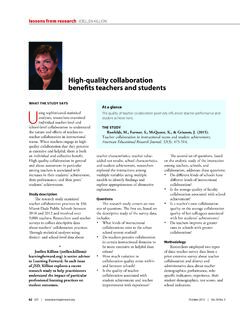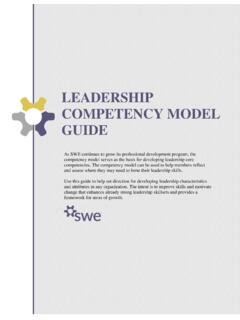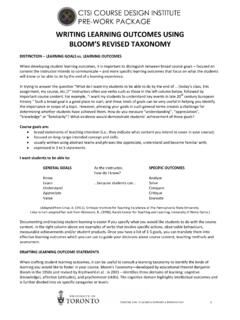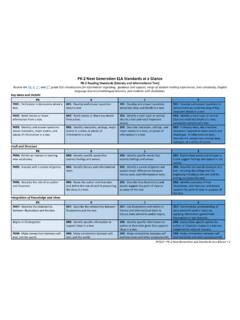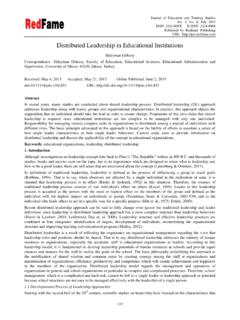Transcription of READING LITERARY (RL) READING ... - Georgia Standards
1 2nd Grade English Language Arts Georgia Standards of Excellence (ELAGSE) Georgia Department of Education April 15, 2015 Page 1 of 6 READING LITERARY (RL) READING INFORMATIONAL (RI) Key Ideas and Details Key Ideas and Details ELAGSE2RL1: Ask and answer such questions as who, what, where, when, why, and how to demonstrate understanding of key details in a text. ELAGSE2RI1: Ask and answer such questions as who, what, where, when, why, and how to demonstrate understanding of key details in a text. ELAGSE2RL2: Recount stories, including fables and folktales from diverse cultures, and determine their central message, lesson, or moral. ELAGSE2RI2: Identify the main topic of a multi-paragraph text as well as the focus of specific paragraphs within the text. ELAGSE2RL3: Describe how characters in a story respond to major events and challenges. ELAGSE2RI3: Describe the connection between a series of historical events, scientific ideas or concepts, or steps in technical procedures in a text.
2 Craft and Structure Craft and Structure ELAGSE2RL4: Describe how words and phrases ( , regular beats, alliteration, rhymes, repeated lines) supply rhythm and meaning in a story, poem, or song. ELAGSE2RI4: Determine the meanings of words and phrases in a text relevant to a grade 2 topic or subje ct area. ELAGSE2RL5: Describe the overall structure of a story including describing how the beginning introduces the story, the middle provides major events and challenges, and the ending concludes the action. ELAGSE2RI5: Know and use various text features ( , captions, bold print, subheadings, glossar ie s, indexes, electronic menus, icons) to locate key facts or information in a text efficiently. ELAGSE2RL6: Acknowledge differences in the points of view of characters, in cludin g by speakin g in a dif ferent voic e for each char acter when READING dialogue aloud. ELAGSE2RI6: Identify the main purpose of a text, including what the author wants to answer, explain, or describ e.
3 Integration of Knowledge and Ideas Integration of Knowledge and Ideas ELAGSE2RL7: Use information gained from the illustrations and words in a print or dig ital text to demonstrate understandin g of its char acters, setting, or plot. ELAGSE2RI7: Explain how specific images ( , a diagram showing how a machin e works ) contribute to and clarif y a text. ELAGSE2RL8: (Not applicable to literature) ELAGSE2RI8: Describe how reasons support specific points the author makes in a text. ELAGSE2RL9: Compare and contrast two or more versions of the same story ( , Cinderella stories) by different authors or from different cultures. ELAGSE2RI9: Compare and contrast the most important points presented by two texts on the same topic. Range of READING and Level of Text Complexity Range of READING and Level of Text Complexity ELAGSE2RL10: By the end of the year, read and comprehend literature, in cludin g stories and poetry, in the grades 2-3 text complexity band profic iently, with scaffold ing as needed at the high end of the range.
4 ELAGSE2RI10: By the end of the year, read and comprehend informational texts, in cludin g his tory/social studies, scie nce, and technic al texts, in the grades 2-3 text complexit y band profic iently, with scaffold in g as needed at the high end of the range. 2nd Grade English Language Arts Georgia Standards of Excellence (ELAGSE) Georgia Department of Education April 15, 2015 Page 2 of 6 Print Concepts Kindergarten and 1st grade only Phonological Awareness Kindergarten and 1st grade only Phonics and Word Recognition READING FOUNDATIONAL (RF) ELAGSE2RF3: Know and apply grade-level phonics and word analysis skills in decoding words. a. distinguish long and short vowels when READING regularly spelled one-syllable words. b. Know spelling-sound correspondences for additional common vowel teams. c. Decode regularly spelled two-syllable words with long vowels. d. Decode words with common prefixes and suffixes.
5 E. Identify words with inconsistent but common spelling-sound correspondences. Fluency ELAGSE2RF4: Read with sufficient accuracy and fluency to support comprehension. a. Read on-level text with purpose and understanding. b. Read on-level text orally with accuracy, appropriate rate, and expression on successive readings. c. Use context to confirm or self-correct word recognition and understanding, rereading as necessary. d. Recognize and read grade-appropriate irregularly spelled words. 2nd Grade English Language Arts Georgia Standards of Excellence (ELAGSE) Georgia Department of Education April 15, 2015 Page 3 of 6 Text Types and Purposes WRITING (W) ELAGSE2W1: Write opinion pieces in which they introduce the topic or book they are writing about, s tate an opinion, supply reasons that support the opinion, use linking words ( , because, and, also) to connect opinion and reasons, and provide a concluding statement or section.
6 ELAGSE2W2: Write informative/explanatory texts in which they introduce a topic, use facts and definitions to develop points, and provide a concluding statement or section. ELAGSE2W3: Write narratives in which they recount a well-elaborated event or short sequence of events, include details to describe actions, thoughts, and feelings, use temporal words to signal event order, and provide a sense of closure. Production and Di stribution of Writing ELAGSE2W4: (Begins in grade 3) ELAGSE2W5: With guidance and support from adults and peers, focus on a topic and strengthen writing as needed by revising and editing. a. May include prewriting. ELAGSE2W6: With guidance and support from adults, use a variety of tools to produce and publish writing, including digital tools and collaboration with peers. Research to Build and Present Knowledge ELAGSE2W7: Participate in shared research and writing projects ( , read a number of books on a single topic to produce a report; record science observations).
7 ELAGSE2W8: Recall information from experiences or gather information from provided sources to answer a question. ELAGSE2W9: (Begins in grade 4) Range of Writing ELAGSE2W10: (Begins in grade 3) 2nd Grade English Language Arts Georgia Standards of Excellence (ELAGSE) Georgia Department of Education April 15, 2015 Page 4 of 6 Comprehension and Collaboration SPEAKING AND LISTENING (SL) ELAGSE2SL1: Participate in collaborative conversations with diverse partners about grade 2 topics and texts with peers and adults in small and larger groups. a. Follow agreed-upon rules for discussions ( , gaining the floor in respectful ways, lis tening to others with care, speaking one at a time about the topics and texts under discussion). b. Build on others talk in conversations by linking their comments to the remarks of others. c. Ask for clarification and further explanation as needed about the topics and texts under discussion.
8 ELAGSE2SL2: Recount or describe key ideas or details from written texts read aloud or information presented orally or through other media. ELAGSE2SL3: Ask and answer questions about what a speaker says in order to clarify comprehension, gather additional information, or deepen understanding of a topic or issue. Presentation of Knowledge and Ideas ELAGSE2SL4: Tell a story or recount an experience with appropriate facts and relevant, descriptive details, speaking audibly in coherent sentences. ELAGSE2SL5: With guidance and support, create audio recordings of stories or poems; add drawings or other visual displays to stories or recounts of experiences when appropriate to clarify ideas, thoughts and feelings. ELAGSE2SL6: Produce complete sentences when appropriate to task and situation in order to provide requested detail or clarification. (See grade 2 Language Standards 1 and 3 for specific expectations.)
9 2nd Grade English Language Arts Georgia Standards of Excellence (ELAGSE) Georgia Department of Education April 15, 2015 Page 5 of 6 Conventions of Standard Englis h LANGUAGE (L) ELAGSE2L1: Demonstrate command of the conventions of standard English grammar and usage when writing or speaking. a. Use collective nouns ( , group). b. Form and use frequently occurring irregular pl ural nouns ( , feet, children, teeth, mice, fish). c. Use reflexive pronouns ( , myself, ourselves). d. Form and use the past tense of frequently occurring irregular verbs ( , sat, hid, told). e. Use adjectives and adverbs, and choose between them depending on what is to be modifi ed. f. Produce, expand, and rearrange complete simple and compound se ntences ( , The boy watched the movie; The little boy watched the movie; The action movie was watched by the little boy). g. Creates documents with legible handwriting.
10 ELAGSE2L2: Demonstrate command of the conventions of standard English capitaliz ation, punctuation, and spelling when writing. a. Capitalize holidays, product names, and geographic names. b. Use commas in greetings and closings of letters. c. Use an apostrophe to form contractions and frequently occurring possessives. d. Generalize learned spelling patterns when writing words ( , cage badge; boy boil). e. Consult reference materials, including beginning dictionaries, as needed to check and correct spellings. Knowledge of Language ELAGSE2L3: Use knowledge of language and its conventions when writing, speaki ng, READING , or listening. a. Compare formal and informal use s of English. Vocabulary Acquisiti on and Use ELAGSE2L4: Determine or clarify the meaning of unknown and multiple-meaning words and phrases based on grade 2 READING and content, choosing flexibly from an array of strategies.










